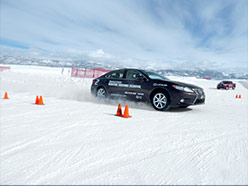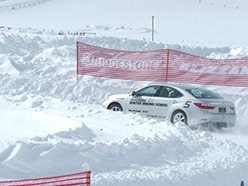February, 2014
Vehicles Used
Lexus ES350

You can’t control the weather, but you can control what tires you put on your vehicle.
That’s Bridgestone’s motto for choosing to drive on proper winter tires when you have to face the worst driving conditions Mother Nature dishes out in the cold winter season. The Blizzak name is synonymous with winter traction and has been a go-to winter tire solution in North America since 1993. With over two decades of evolution, the newest Bridgestone Studless Ice & Snow tire, the Blizzak WS80, is designed to take yet another step forward in the march towards higher levels of traction and control on slushy, snowy, ice-covered, wet or simply cold and dry roads.
The Blizzak WS80’s first area of improvement increases traction in the snow and on ice. Bridgestone has developed yet another Multicell compound to cope with the thin film of water that forms where the tire contacts the snow or ice surface. Even in sub-freezing temperatures, friction and pressure from the weight of the vehicle temporarily melts the very top layer of an icy or packed snow surface. That thin film of water acts as a lubricant, making it that much harder for the tire to get traction on the already slippery road.
The new Multicell compound deals with this traction challenge in two ways. The first is the presence of many tiny air pockets in the tread rubber. Looking a lot like Swiss cheese if viewed with a microscope, the tiny bubbles in the shape of tubes and cells work to temporarily wick away some of the water that forms under the tire’s contact patch. This puts the tread rubber in better contact with the surface for improved traction. While Bridgestone has used a Multicell compound on several generations of Blizzak tires, what makes it different this time around is a special hydrophilic coating on the inside of each bubble. Being hydrophilic essentially means it attracts water, drawing more into each bubble than with previous versions, for enhanced traction. Bridgestone has also added tiny bite particles embedded in the tread rubber that act like microscopic studs to help scratch at the snow/ice surface.
Bridgestone has also tuned the tread compound to be even more pliable at cold temperatures than in the past, helping it conform to irregular surfaces for better traction.
 Carefully re-designed zig-zag sipes add critical biting edges, while also interlocking for tread block stability and better handling. Revised tread block shape and size increase the number of biting block edges by 20% over the previous generation Blizzak WS70. All this rides on a carefully tuned contact patch shape that optimizes pressure in the tire footprint for a claimed 10% improvement in snow traction.
Carefully re-designed zig-zag sipes add critical biting edges, while also interlocking for tread block stability and better handling. Revised tread block shape and size increase the number of biting block edges by 20% over the previous generation Blizzak WS70. All this rides on a carefully tuned contact patch shape that optimizes pressure in the tire footprint for a claimed 10% improvement in snow traction.
All together, the new Multicell tread compound, revised tread pattern and more pliable tread compound in cold temperatures work together to improve snow, slush and ice traction versus previous Blizzak tires.
To get an advance look at how the Blizzak WS80 performs, Bridgestone invited select tire dealers and members of the media to Steamboat Springs, Colorado to experience production-spec Blizzak WS80 tires in their natural habitat, driving on snow and ice.
Poise on the Ice
The first demonstration was held at a hockey rink, using the rink’s cold temperatures, glare ice and low traction to challenge the tire’s acceleration and braking traction. Two identical Lexus ES350 sedans were equipped with Bridgestone Blizzak WS80 and Michelin X-Ice Xi3 tires. Both sets of tires had been driven 6,200 miles on clear roads prior to the demo, as a means of simulating a season of use and wear.
The first part of the ice demonstration simulated a start from a slippery intersection by having drivers accelerate from a standstill at the goal line towards center ice, relying on the ES350’s traction control system to help minimize wheelspin and maximize acceleration. Getting started from the very polished start point challenged both tires, with the Blizzak WS80 able to get rolling more quickly and with noticeably less intervention from the vehicle’s traction control system. The Michelin X-Ice Xi3 could get the car rolling, but consistently took longer to get moving than the car equipped with the Blizzak WS80s. With over a dozen drivers participating in our group the average terminal speed at the center ice line was 1.6 mph faster with the Blizzak WS80 than the X-Ice Xi3. That may not sound like much but it’s 17.8%, which felt significant from behind the wheel.
Getting rolling is one thing, but stopping is another. So the second part of the demo was a simulated panic stop starting at the center ice line. Drivers applied the brakes hard enough to immediately engage the car’s Antilock Brake System, riding it to a full stop. Onboard Vericom VC3000 computers measured the speed at initiation and how far it took to bring the car to a stop. Results were similar to the acceleration test, with the Blizzak WS80-equipped car taking noticeably less distance to stop. Using a standard formula to correct any variation in speed at initiation to the target of 10 mph, the car equipped with Blizzak WS80s stopped 9.5-feet or 22.1% sooner than the vehicle with the Michelin X-Ice Xi3 tires.
| Tire |
Avg. Speed at Center
Ice Line (mph) |
ABS Stop Distance
10-0 mph (feet) |
| Bridgestone Blizzak WS80 |
10.6 |
33.5 |
| Michelin X-Ice Xi3 |
9.0 |
43.0 |
Traction and Handling In the Snow

A short ride took us to the Bridgestone Winter Driving School, located in the rolling hills just outside of town. Here we found more Lexus ES350s ready to take on the school’s snow-covered, serpentine courses flowing over the rolling terrain, which would provide plenty of challenge to tire traction going up and down hills and around a variety of corner shapes and sizes. Tires were new with some break-in miles driven on clear roads.

The first course was driven in two vehicles with Blizzak WS80 and Michelin X-Ice Xi3 tires. The course layout was designed to challenge the braking and steering traction of both tires. Each driver took several laps in each car with the vehicle’s stability and traction control left on to simulate how most people drive out on public roads. Several of the maneuvers were designed to brake and steer at the same time, similar to an avoidance maneuver. The drive was purely subjective and both tires were good when braking in a straight line. But when asked to brake and steer simultaneously the Blizzak WS80 felt more sure-footed and responded to steering inputs with more authority than the X-Ice Xi3.
The second course compared the Blizzak WS80 to the Goodyear Ultra Grip Ice WRT. Also just a subjective evaluation driven with the stability and traction control turned on, this course featured more sweeping turns and steady-state cornering sections than the first course. Here the overall traction and controllability advantage of the Blizzak WS80 was more apparent than in the first demo. The car equipped with the Blizzak WS80 was easier to control, cornered with more stability and could drive at an overall faster speed than the one riding on the Ultra Grip Ice WRT tires.
Summary
The demonstrations Bridgestone put together showcased the Blizzak WS80’s impressive snow and ice traction, which seems like a nice evolutionary step beyond the already respected capability of its predecessor, the Blizzak WS70. Tire Rack will be doing a complete test with production tires in the fall and winter of 2014/15. Be sure to check back for the results of that test, or sign up for email alerts of test results here.


 Carefully re-designed zig-zag sipes add critical biting edges, while also interlocking for tread block stability and better handling. Revised tread block shape and size increase the number of biting block edges by 20% over the previous generation Blizzak WS70. All this rides on a carefully tuned contact patch shape that optimizes pressure in the tire footprint for a claimed 10% improvement in snow traction.
Carefully re-designed zig-zag sipes add critical biting edges, while also interlocking for tread block stability and better handling. Revised tread block shape and size increase the number of biting block edges by 20% over the previous generation Blizzak WS70. All this rides on a carefully tuned contact patch shape that optimizes pressure in the tire footprint for a claimed 10% improvement in snow traction.


